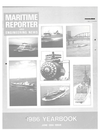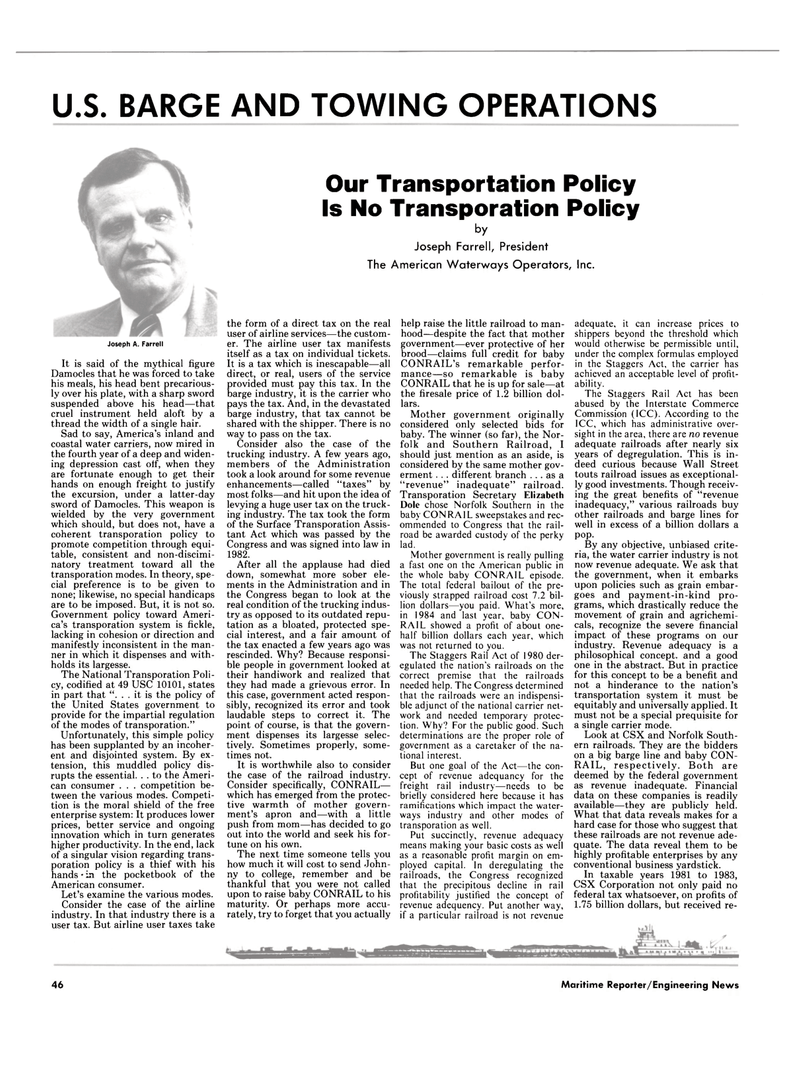
Page 46: of Maritime Reporter Magazine (June 1986)
Read this page in Pdf, Flash or Html5 edition of June 1986 Maritime Reporter Magazine
U.S. BARGE AND TOWING OPERATIONS
Joseph A. Farrell
It is said of the mythical figure
Damocles that he was forced to take his meals, his head bent precarious- ly over his plate, with a sharp sword suspended above his head—that cruel instrument held aloft by a thread the width of a single hair.
Sad to say, America's inland and coastal water carriers, now mired in the fourth year of a deep and widen- ing depression cast off, when they are fortunate enough to get their hands on enough freight to justify the excursion, under a latter-day sword of Damocles. This weapon is wielded by the very government which should, but does not, have a coherent transporation policy to promote competition through equi- table, consistent and non-discimi- natory treatment toward all the transporation modes. In theory, spe- cial preference is to be given to none; likewise, no special handicaps are to be imposed. But, it is not so.
Government policy toward Ameri- ca's transporation system is fickle, lacking in cohesion or direction and manifestly inconsistent in the man- ner in which it dispenses and with- holds its largesse.
The National Transporation Poli- cy, codified at 49 USC 10101, states in part that ". . . it is the policy of the United States government to provide for the impartial regulation of the modes of transporation."
Unfortunately, this simple policy has been supplanted by an incoher- ent and disjointed system. By ex- tension, this muddled policy dis- rupts the essential. . . to the Ameri- can consumer . . . competition be- tween the various modes. Competi- tion is the moral shield of the free enterprise system: It produces lower prices, better service and ongoing innovation which in turn generates higher productivity. In the end, lack of a singular vision regarding trans- poration policy is a thief with his hands • in the pocketbook of the
American consumer.
Let's examine the various modes.
Consider the case of the airline industry. In that industry there is a user tax. But airline user taxes take
Our Transportation Policy
Is No Transporation Policy by
Joseph Farrell, President
The American Waterways Operators, Inc. the form of a direct tax on the real user of airline services—the custom- er. The airline user tax manifests itself as a tax on individual tickets.
It is a tax which is inescapable—all direct, or real, users of the service provided must pay this tax. In the barge industry, it is the carrier who pays the tax. And, in the devastated barge industry, that tax cannot be shared with the shipper. There is no way to pass on the tax.
Consider also the case of the trucking industry. A few years ago, members of the Administration took a look around for some revenue enhancements—called "taxes" by most folks—and hit upon the idea of levying a huge user tax on the truck- ing industry. The tax took the form of the Surface Transporation Assis- tant Act which was passed by the
Congress and was signed into law in 1982.
After all the applause had died down, somewhat more sober ele- ments in the Administration and in the Congress began to look at the real condition of the trucking indus- try as opposed to its outdated repu- tation as a bloated, protected spe- cial interest, and a fair amount of the tax enacted a few years ago was rescinded. Why? Because responsi- ble people in government looked at their handiwork and realized that they had made a grievous error. In this case, government acted respon- sibly, recognized its error and took laudable steps to correct it. The point of course, is that the govern- ment dispenses its largesse selec- tively. Sometimes properly, some- times not.
It is worthwhile also to consider the case of the railroad industry.
Consider specifically, CONRAIL— which has emerged from the protec- tive warmth of mother govern- ment's apron and—with a little push from mom—has decided to go out into the world and seek his for- tune on his own.
The next time someone tells you how much it will cost to send John- ny to college, remember and be thankful that you were not called upon to raise baby CONRAIL to his maturity. Or perhaps more accu- rately, try to forget that you actually help raise the little railroad to man- hood—despite the fact that mother government—ever protective of her brood—claims full credit for baby
CONRAIL's remarkable perfor- mance—so remarkable is baby
CONRAIL that he is up for sale—at the firesale price of 1.2 billion dol- lars.
Mother government originally considered only selected bids for baby. The winner (so far), the Nor- folk and Southern Railroad, I should just mention as an aside, is considered by the same mother gov- erment.. . different branch ... as a "revenue" inadequate" railroad.
Transporation Secretary Elizabeth
Dole chose Norfolk Southern in the baby CONRAIL sweepstakes and rec- ommended to Congress that the rail- road be awarded custody of the perky lad.
Mother government is really pulling a fast one on the American public in the whole baby CONRAIL episode.
The total federal bailout of the pre- viously strapped railroad cost 7.2 bil- lion dollars—you paid. What's more, in 1984 and'last year, baby CON-
RAIL showed a profit of about one- half billion dollars each year, which was not returned to you.
The Staggers Rail' Act of 1980 der- egulated the nation's railroads on the correct premise that the railroads needed help. The Congress determined that the railroads were an indispensi- ble adjunct of the national carrier net- work and needed temporary protec- tion. Why? For the public good. Such determinations are the proper role of government as a caretaker of the na- tional interest.
But one goal of the Act—the con- cept of revenue adequancy for the freight rail industry—needs to be briefly considered here because it has ramifications which impact the water- ways industry and other modes of transporation as well.
Put succinctly, revenue adequacy means making your basic costs as well as a reasonable profit margin on em- ployed capital. In deregulating the railroads, the Congress recognized that the precipitous decline in rail profitability justified the concept of revenue adequency. Put another way, if a particular railroad is not revenue adequate, it can increase prices to shippers beyond the threshold which would otherwise be permissible until, under the complex formulas employed in the Staggers Act, the carrier has achieved an acceptable level of profit- ability.
The Staggers Rail Act has been abused by the Interstate Commerce
Commission (ICC). According to the
ICC, which has administrative over- sight in the area, there are no revenue adequate railroads after nearly six years of degregulation. This is in- deed curious because Wall Street touts railroad issues as exceptional- ly good investments. Though receiv- ing the great benefits of "revenue inadequacy," various railroads buy other railroads and barge lines for well in excess of a billion dollars a pop.
By any objective, unbiased crite- ria, the water carrier industry is not now revenue adequate. We ask that the government, when it embarks upon policies such as grain embar- goes and payment-in-kind pro- grams, which drastically reduce the movement of grain and agrichemi- cals, recognize the severe financial impact of these programs on our industry. Revenue adequacy is a philosophical concept, and a good one in the abstract. But in practice for this concept to be a benefit and not a hinderance to the nation's transportation system it must be equitably and universally applied. It must not be a special prequisite for a single carrier mode.
Look at CSX and Norfolk South- ern railroads. They are the bidders on a big barge line and baby CON-
RAIL, respectively. Both are deemed by the federal government as revenue inadequate. Financial data on these companies is readily available—they are publicly held.
What that data reveals makes for a hard case for those who suggest that these railroads are not revenue ade- quate. The data reveal them to be highly profitable enterprises by any conventional business yardstick.
In taxable years 1981 to 1983,
CSX Corporation not only paid no federal tax whatsoever, on profits of 1.75 billion dollars, but received re- 1 46 Maritime Reporter/Engineering News

 45
45

 47
47
